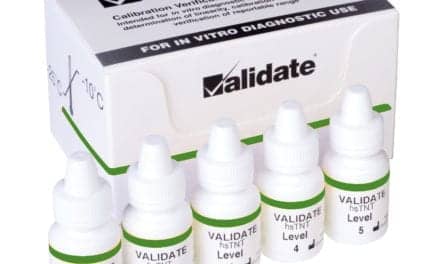Beckman Coulter Diagnostics, Brea, Calif, has announced the commercialization of its DxM MicroScan Walkaway system, a diagnostic solution for bacterial identification and antibiotic susceptibility testing for microbiology laboratories.
The DxM MicroScan Walkaway system uses direct minimum-inhibitory concentrations (MIC) for the detection of antimicrobial resistance, offering greater confidence in results through gold-standard accuracy and broad first-time reporting.1 The system supports microbiology laboratories that seek to optimize patient care while reducing the risks, costs, and operational burdens of emerging antimicrobial resistance.
“The DxM MicroScan WalkAway system gives our clinical laboratory partners the ability to identify emerging resistance with the highest levels of accuracy, ensuring optimal patient care,” says Joseph Repp, senior vice president and general manager for microbiology at Beckman Coulter. “Laboratories can have utmost confidence in the performance of our technology, which has been given number-one ratings by ServiceTrak for software ease of use and technical application support.”
Antimicrobial resistance threatens the effective prevention and treatment of an ever-increasing range of infections caused by bacteria, fungi, parasites, and viruses.2 Antimicrobial resistance is an increasingly serious threat to public health that requires global action. The Centers for Disease Control and Prevention has called antibiotic resistance public health’s ticking time bomb.3 In the United States and Europe, up to 50,000 people die each year as a result of antimicrobial resistance, and one study projects that by the year 2050 10 million people a year could die from this global crisis.3,4,5
The timely and accurate detection of antimicrobial resistance is of critical importance for ensuring that patients are protected against the risk of worsening infection or its progression to life-threatening conditions such as sepsis or septic shock.
“We are one of the first hospitals in the country to use MicroScan,” says Rachael Arkley, laboratory manager and head biomedical scientist at William Harvey Hospital, Willesborough, UK. “It gives our staff great confidence and means we are fully geared up in advance of any outbreak.”
The DxM MicroScan Walkaway solution is designed to keep laboratories at the forefront of bacterial identification and susceptibility testing, with proven detection of emerging resistance to the toughest pathogens.
“As new issues have arisen, such as carbapenemases or other resistance mechanisms, MicroScan has adapted,” says Emilia Cercenado, PhD, a pharmacist and microbiologist at the Hospital General Universitario Gregorio Marañón, Madrid. “The panels have been updated to assist us in identifying these new resistance mechanisms.”
At the same time, the system’s delivery of first-time, gold-standard, MIC accuracy helps laboratories achieve their operational goals by reducing costs associated with offline confirmatory testing. Added workflow enhancements include a fluid-level sensing technology for added assurance, easy-to-view external LED indicators that show status at a glance, a quick-release mechanism that simplifies bottle removal for reagent maintenance, and integrated reliability improvements that maximize uptime.
For more information, visit Beckman Coulter Diagnostics.
References
- The Worldwide Market for In Vitro Diagnostic (IVD) Tests. 10th ed. New York City: Kalorama Information, 2016. Available at: www.kaloramainformation.com/worldwide-vitro-diagnostic-10206771. Accessed September 19, 2018.
- Antimicrobial resistance [online]. Geneva: World Health Organization, 2017. Available at: www.who.int/antimicrobial-resistance/en. Accessed September 19, 2018.
- Fact sheet: detect and protect against antibiotic resistance [online]. Atlanta, Centers for Disease Control and Prevention, 2014. Available at: www.cdc.gov/drugresistance/pdf/ar_initiative_fact_sheet.pdf. Accessed September 19, 2018.
- Antibiotic resistance [online]. Copenhagen: World Health Organization Regional Office for Europe, 2018. Available at: www.euro.who.int/en/health-topics/disease-prevention/antimicrobial-resistance/antibiotic-resistance. Accessed September 19, 2018.
- O’Neill J. Antimicrobial Resistance: Tackling a Crisis for the Health and Wealth of Nations. London: Review on Antimicrobial Resistance, 2014. Available at: https://amr-review.org/sites/default/files/AMR%20Review%20Paper%20-%20Tackling%20a%20crisis%20for%20the%20health%20and%20wealth%20of%20nations_1.pdf. Accessed September 19, 2018.






please send me a manual about dxm microscan thank you good year 2021